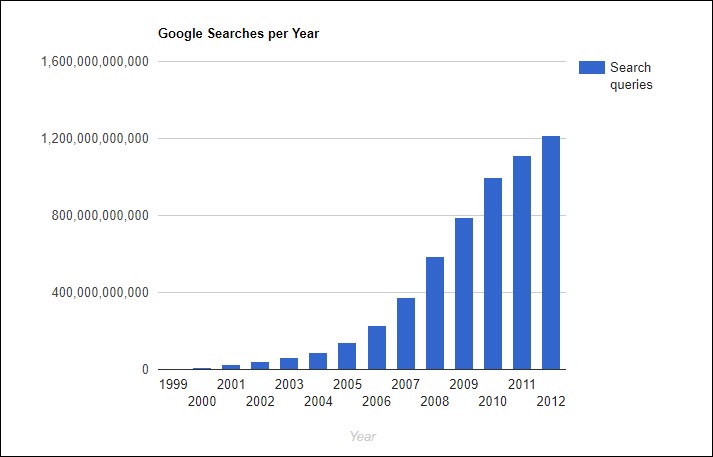Did you know that Google processes over 40,000 search queries every single second? This translates to over 3.5 billion searches per day: more than 1.2 trillion searches in a single year. Despite these eyebrow-raising figures, 15 percent of Google searches have never been searched before.
Look at the numbers below. They climb upwards, rapidly, each year:
With so many completely unique Google searches, just imagine the number of “unicorn” keywords hiding out there. They’d receive comparatively little traffic, but potentially be product ad goldmines were you to target enough of them. In fact, most keywords don’t receive enough searches per month to take them out of this “scarce data” range.
In PPC, marketers look for keywords as high in volume and low in competition as possible…while showing that searchers have some buying intent. However, as the industry becomes more competitive, these high-value keywords become increasingly difficult to find. Many product ad keywords with higher volume levels require constant monitoring to avoid overbidding. This reduces any return from those advertising efforts.
With the right tech solutions in place, a bounty of unique Google searches presents lots of opportunities for scarce data bidding. So, just what is scarce data bidding? And why is it such a powerful strategy for eCommerce companies?
What is Scarce Data Bidding?
Scarce data bidding is the process of bidding on keywords for which little data exists. You can find these keywords using a keyword tool, or in your own internal documentation, discovered through broad-match PPC campaigns.
Like any keyword you can track their effectiveness and optimize them for conversions. So, what’s the main difference between scarce data bidding and traditional PPC bidding strategies? There’s no prize for guessing what it is that scarce data keywords lack! They can’t be used to influence strategic decisions unless you’ve first targeted large numbers of them.
Because they usually represent more specific searches, most scarce data keywords fall into the longtail category. With product ads, longer search terms reflect higher buying intent. As a result, scarce data keywords provide valuable opportunities to companies with products that match those queries, even if the search volume is low.
Scarce data keywords offer less competition than keywords with higher search volumes. And this lack of rivalry can make for extremely high returns for your bids. Of course, the cost—in both time and resources—may be prohibitive. But the lure of richly-performing keywords (and a boost to account performance) makes it a tough proposition to ignore.
Bringing in Automation for Scarce Data Bidding Success
That said, you need a system in place that doesn’t just identify scarce data opportunities. It must also manage the bids for large groups of keywords.
To truly manage scarce data bidding strategies effectively, automation is your friend. Marketers need to identify hundreds (or thousands) of keywords they’d like to target. They have to manage the bidding for each of those keywords separately, or in collective ad groups.
At Crealytics, we’re piloting a new feature that sidesteps these issues. Our technology uses algorithmic signals to capitalize on low-traffic keywords—saving on manual labor in the process. To see what we can do for your eCommerce campaigns, why not get in touch today?





